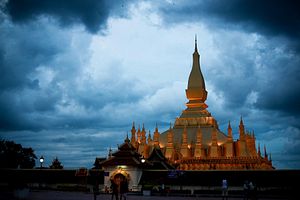Past policies that have enabled Laos to meet the UN’s least developed country (LDC) graduation thresholds are no longer adequate to ensure sustainable development. The focus of future policies should be on fostering greater productive capacity, increased economic diversification and enabling a stronger business environment.
The UN’s 2018 triennial review of Laos’ LDC status found that the country is eligible for graduation for the first time, having passed thresholds for two of the three graduation criteria: gross national income per capita and the human assets index. While not yet meeting the threshold for the economic vulnerability index, the remaining criterion, Laos has managed to reduce this index to a level close to the required threshold.
If at least the current level of progress is maintained, Laos will graduate from LDC status in 2024, three years after its next triennial review set for 2021.
Laos’ rapid economic growth has changed its economic structure. The agricultural sector’s share of gross domestic product (GDP) is declining while that of the services and industry sectors is increasing. Such structural change has largely been characterized by diversification toward resource-based developments such as mining and hydropower. Since the mid-2000s these developments have stimulated export booms and changed the country’s export structure.
Diversification within sectors has also been observed. Manufacturing, which traditionally concentrated on the production of garments, has grown and diversified to parts and components as well as machinery and transport equipment. As a result, manufacturing’s share of merchandise exports increased from 12.9 per cent in 2013 to 22.3 per cent in 2017.
Attracted by low labor costs and market access to developed countries, foreign direct investment (FDI) into the garments sector has led to an export-oriented manufacturing surge. This sector was a major source of foreign exchange earnings and represented more than 40 per cent of total merchandise exports between 2001 and 2004. But its importance has since subsided to only 5.6 per cent of total merchandise exports in 2017.
Laos’ exports took off after 2005 due to FDI in two large mining projects. Log and wood product exports also increased and was mainly driven by neighboring countries’ increasing demand. The average annual growth rate of exports surged from 2.4 per cent between 1996 and 2004 to 17.6 per cent between 2005 and 2017.
The services sector — tourism, banking, transport and distribution — also expanded thanks to further economic liberalization and spillovers from natural resource development. But despite the growth, higher value-added services account for a small part of the sector. The Lao Statistics Bureau revealed that logistics, financial and information and communications technology services together represented roughly 6 percent of GDP and 3.7 per ent of employment in 2017. In agriculture, diversification can be observed in a transition away from subsistence production, mainly rice, towards cash crops such as coffee, tea, bananas, rubber and beans.
These transformations have had little impact on the composition of employment. Employment remains highly concentrated in the low productivity agriculture sector and there is little movement from low-productivity to higher-productivity production — explaining the limited impacts of strong growth on poverty reduction. Diversifying the economy and exports towards more labour-intensive and higher value-added activities is necessary for sustained and inclusive long-term growth.
To achieve sustainable development, economic diversification is the most suitable policy for structural transformation. The reason why the country’s strong growth has not had a desirable impact on either reducing poverty or creating decent employment is that it has not been accompanied by the development of productive capacities in a wider range of activities — a necessary condition to make economic growth inclusive and its proceeds broadly shared.
The emergence of capital-intensive natural resources activities — the country’s path to LDC graduation — has reduced Laos’ economic vulnerability index. It has reduced export concentration, export instability and the share of agriculture in GDP. But it also brings new risks. The country’s growth and socioeconomic progress are now highly dependent upon mining, electricity prices and weather conditions. The resources sector’s low capacity to create employment and high potential to generate negative environmental impacts and economic vulnerabilities will need to be mitigated.
This puts at risk the country’s LDC graduation in 2024 and highlights the importance of building economic resilience for sustainable development. Building resilience requires sound development strategies to advance productive capacities, increase competition, diversify the national economy, create an enabling environment for investment and strengthen national capacities to mitigate environmental shocks. Particular attention ought to be placed on institutions, human capital and information and communications technology.
Dr Buavanh Vilavong is Director General of the Department of Industry and Handicraft under the Ministry of Industry and Commerce in Laos.
Dr Sitthiroth Rasaphone is Acting Director General of the Center for Development Policy Research under the Ministry of Planning and Investment in Laos.
This piece was originally published over at East Asia Forum here, and is republished with permission.

































